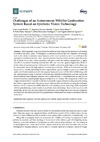Please use this identifier to cite or link to this item:
https://accedacris.ulpgc.es/jspui/handle/10553/45630
| Title: | Challenges of an autonomous wildfire geolocation system based on synthetic vision technology | Authors: | Araña Pulido, Víctor Alexis Cabrera-Almeida, Francisco Pérez Mato, Javier Dorta-Naranjo, B. Pablo Hernández-Rodríguez, Silvia Jiménez Yguacel, Eugenio |
UNESCO Clasification: | 332506 Comunicaciones por satélite 250505 Teoría de la localización |
Keywords: | Thermography Infrared Geolocation Wildfire Sensor networks, et al |
Issue Date: | 2018 | Journal: | Sensors | Abstract: | Thermographic imaging has been the preferred technology for the detection and tracking of wildfires for many years. Thermographic cameras provide some very important advantages, such as the ability to remotely detect hotspots which could potentially turn into wildfires if the appropriate conditions are met. Also, they can serve as a key preventive method, especially when the 30-30-30 rule is met, which describes a situation where the ambient temperature is higher than 30 ∘ C, the relative humidity is lower than 30%, and the wind speed is higher than 30 km/h. Under these circumstances, the likelihood of a wildfire outburst is quite high, and its effects can be catastrophic due to the high-speed winds and dry conditions. If this sort of scenario actually occurs, every possible technological advantage shall be used by firefighting teams to enable the rapid and efficient coordination of their response teams and to control the wildfire following a safe and well-planned strategy. However, most of the early detection methods for wildfires, such as the aforementioned thermographic cameras, lack a sufficient level of automation and usually rely on human interaction, imposing high degrees of subjectivity and latency. This is especially critical when a high volume of data is required in real time to correctly support decision-making scenarios during the wildfire suppression tasks. The present paper addresses this situation by analyzing the challenges faced by a fully autonomous wildfire detection and a tracking system containing a fully automated wildfire georeferencing system based on synthetic vision technology. Such a tool would provide firefighting teams with a solution capable of continuously surveilling a particular area and completely autonomously identifying and providing georeferenced information on current or potential wildfires in real time. | URI: | https://accedacris.ulpgc.es/handle/10553/45630 | ISSN: | 1424-8220 | DOI: | 10.3390/s18113631 | Source: | Sensors (Basel, Switzerland) [ISSN 1424-8220], v. 18 (11), 3631 |
| Appears in Collections: | Artículos |
Items in accedaCRIS are protected by copyright, with all rights reserved, unless otherwise indicated.
